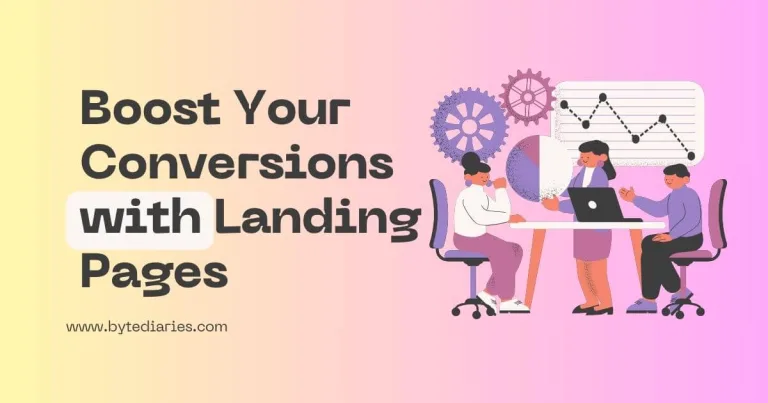What is a Landing Page and Why is it Crucial for Your Business?
A landing page is your secret weapon for turning visitors into customers. Unlike your homepage or blog, which serve multiple purposes, a landing page has one mission: conversion.
Whether it’s getting sign-ups, making sales, or collecting leads, every element on the page is designed to push visitors toward a single action.
Used in marketing campaigns and linked to ads, emails, or social media, landing pages minimize distractions, providing a clear path for users to complete their goals. It’s all about focusing on what matters most—results.
Table of Content
Why Landing Pages Matter
Landing pages are vital for achieving your marketing and business goals. Here’s why:
- Higher Conversion Rates: A well-designed landing page is more likely to convert visitors than other types of web pages. With a clear CTA and focused content, the visitor knows exactly what to do next.
- Focused Messaging: A landing page can deliver one clear message that resonates with visitors, unlike your homepage, which might have several competing messages. This focus improves engagement and drives action.
- Measurable Results: Landing pages provide a clear way to track and measure performance. By analyzing metrics like visitor behavior, conversion rates, and bounce rates, you can refine your strategy over time.
- Cost-Effective: Whether you’re promoting a product, service, or lead magnet, landing pages offer a cost-effective way to target specific audiences and optimize your marketing budget.
For small businesses, landing pages are an indispensable tool for attracting leads and driving conversions.
Key Elements of a High-Performing Landing Page
A high-converting landing page contains several key elements. Let’s explore them in detail:
- Clear Headline: The headline should immediately grab your visitor’s attention. It should clearly state the benefit or value proposition. It’s the first thing they’ll see, so make it count.
Example: “Get Your Free eBook Today!” or “Boost Your Sales with Our Proven Strategies” - Compelling Copy: Keep your content engaging and focused on the benefits. Avoid jargon or fluff—explain why your offer is valuable and how it solves a problem.
- Call to Action (CTA): Your CTA is the focal point of your landing page. It should be action-oriented and visually distinct. Use strong, clear language like “Sign Up Now” or “Get Started”.
- Visuals: Images, videos, or graphics can help to clarify your message. For example, if you’re offering a product, show the product in action or use videos to explain how it works.
- Social Proof: Including testimonials, reviews, or certifications can build trust and convince visitors that your offer is legitimate.
Example: “Over 10,000 satisfied customers worldwide!” - Lead Capture Forms: If your goal is to collect user information, keep your form simple and user-friendly. Only ask for essential details to reduce friction.
- Minimal Distractions: Limit navigation links, sidebars, and other elements that could divert attention away from your CTA. Keep the focus on your main goal.
Examples of Effective Landing Pages
Let’s look at a few examples of landing pages that are highly effective at converting visitors:
- Unbounce: This landing page is designed to show visitors the value of using Unbounce for creating landing pages. It features a strong headline, a clear CTA, and supporting social proof. The page is clean, with a single focus—getting users to try their product.
- Airbnb’s Host Signup: Airbnb’s landing page for new hosts showcases the benefits of hosting. With a clean design and clear CTAs like “Get Started” or “Sign Up”, it’s easy for visitors to take action. Social proof from current hosts is also included.
- Shopify’s Free Trial Offer: Shopify’s landing page offers a straightforward CTA for a free trial. The page includes a brief description of the platform’s features, testimonials, and a clear CTA—“Start Free Trial”.
These landing pages excel because they have strong headlines, clear CTAs, supporting visuals, and social proof, all contributing to higher conversion rates.
Common Landing Page Mistakes to Avoid
Even the best-designed landing pages can underperform if not carefully optimized. Here are some common mistakes to avoid:
- Cluttered Design: Too much information or too many design elements can overwhelm visitors. Keep your landing page clean and focused on the main message.
- Unclear Value Proposition: If visitors don’t understand the benefits immediately, they’ll leave. Make sure your headline and copy are crystal clear.
- Weak or Confusing CTAs: If your CTA is unclear or too subtle, visitors may not know what to do next. Use action-oriented language and ensure the CTA stands out.
- Slow Load Times: A slow-loading landing page leads to high bounce rates. Optimize images and minimize the page’s file size for faster load times.
- Not Mobile-Friendly: A growing number of users browse on mobile devices. Ensure your landing page is responsive and provides a seamless experience on all screen sizes.
- Lack of Testing: Without A/B testing, you’ll never know what works best for your audience. Test different headlines, CTAs, and designs to improve performance.
How to Improve Landing Page Performance: 5 Tips
To get the most out of your landing pages, here are a few strategies for improving landing page performance:
- A/B Testing: Experiment with different headlines, CTAs, and layouts to find out what resonates best with your audience. A/B testing helps you continuously improve your landing pages based on real user data.
- Use Analytics: Monitor metrics like bounce rate, conversion rate, and time on page to identify where visitors are dropping off. Use this data to make informed improvements.
- Optimize for Speed: Compress images, minimize code, and leverage browser caching to ensure your landing page loads quickly.
- Improve Mobile Optimization: More users are visiting websites via smartphones. Make sure your landing page is responsive, with elements that adjust to fit smaller screens.
- Use Clear CTAs: Your CTA should be action-driven and easy to spot. Test different CTA buttons and positions to see which one gets the most clicks.
Why Choose Professional Web Development for Your Landing Page
Creating a high-converting landing page is an art and a science. While DIY tools can help, professional web development ensures that your landing page is optimized for performance, usability, and conversion.
As a web developer, I can help you create landing pages that not only look great but also drive results. From setting up A/B tests to ensuring mobile responsiveness and fast load times, a professional touch can elevate your landing page’s performance.
Also read: Why small business websites are important for success
Conclusion
A well-crafted landing page can be the difference between a successful campaign and a wasted marketing effort. By focusing on the right elements—clear headlines, compelling copy, and strong CTAs—you can significantly improve your landing page performance. Avoid common mistakes, regularly test your designs, and optimize for speed and mobile devices.
If you want to create high-converting landing pages tailored to your business goals, reach out for expert web development services. With the right approach, your landing pages can boost conversions and drive business success.
FAQs
- What is the purpose of a landing page?
A landing page’s main purpose is to convert visitors into leads or customers by directing them toward a single goal, such as signing up or making a purchase.
- How long should a landing page be?
Keep it concise and to the point—aim for a length that provides all necessary information but doesn’t overwhelm the visitor. Usually, 1-2 scrolls are ideal.
- What makes a landing page effective?
A clear headline, compelling copy, strong CTA, and relevant social proof are key factors. Test different variations to see what works best for your audience.
- Should I use images on my landing page?
Yes, visuals can enhance the message, but they should support your copy and not overwhelm the page. Use high-quality images that are relevant to the offer.
- How can I start improving landing page performance?
Start by optimizing the load speed, using a clear CTA, and testing different headlines or design layouts. Analytics and A/B testing are essential for identifying improvements that will boost conversions.


